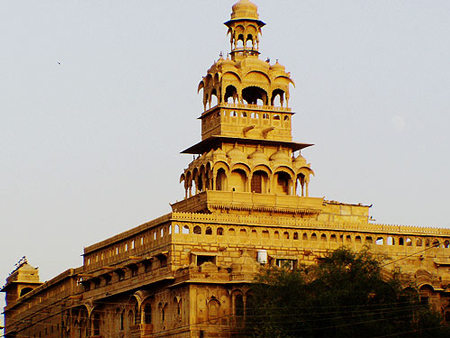Dr.Mazhar Naqvi
Tazia
Tower in the desert city of Jaisalmer ( India) is perhaps the only of its kind in the world. This awesome piece of architecture was constructed in the form of a Tazia by Muslim craftsmen as a gift to their Hindu king Maharawal Barisal Singh
in 1886.The tower symbolizes the secular identity of the region. Ranked as one
of the most conspicuous building among the new palaces
built by Jaisalmer rulers, under the influence of British, the five storied tower stands
tall with it’s over imposing structure amidst the picturesque landscape of the
golden sand dunes of Jaisalmer.
It is believed that when the fort of Jaisalmer
became too congested for the royal family and the state became a protectorate
of British, Maharawal built two palaces namely Jawahar Vilas and Badal Vilas. While
Jawahar Vilas was built to accommodate the British resident, the other building,
also known as Badal Mahal the royal household kept for its own use. Tazia tower
is in fact an integral part of Badal Mahal. The craftsmen deployed to raise the
magnificent palace were directed to erect it as an observation tower and they
gave it shape as that of Tazia to symbolize the secular nature of the princely
state and their emotional attachment to the family of holy Prophet.
Founded in 1156 AD by Rawal Jaisal,
the city was a flourishing town in medieval period. It was a large trading center
and its prosperity was due to its location on
the main trade route linking India to Egypt, Arabia, Persia, Africa and the Western countries. After partition, it became a deserted city as the trading route
was blocked. Jaisalmer remained untouched
by outside influence for a long period and reemerged as a major
tourist destination after the construction of Indira Canal and discovery of oil
in Thar desert. Tazia tower too remained unknown to the outside world but it became a popular destination when Jaisalmer witnessed turn around and
earned worldwide fame for its desert festival and sand dunes.
Tazia refers to ornately decorated bamboo,
paper and tinsel replicas of a bier carried in procession during observance of
Muharram to recall the martyrdom of Hazrat Imam Hussain in
Karbala in 680 AD. All over the world there are shrines dedicated to Imam
Hussain and even other Imams revered by Imamis.
Shrines located in Najaf, Karbala, Mashhad, Samra and Qum are majestic, richly decorated and masterpiece of Islamic architecture. Even their replicas in India , Pakistan and Afghanistan are a visual treat.
In Lucknow, Srinagar, Gilgit, Baltistan, Lahore, Multan and Mazar-e-Sharif, shrines dedicated to Panjatan are imposing and attracting large number of devotees during the period Muharram. . But nowhere else is Tazia tower, only Jaisalmer has this unique distinction. The significance of the tower also lies in the fact that it was built by Muslim craftsmen for their Hindu ruler. It reflects the true meaning of Imam Hussain’s sublime sacrifice for humanity and universal brotherhood.( References available on request)
Shrines located in Najaf, Karbala, Mashhad, Samra and Qum are majestic, richly decorated and masterpiece of Islamic architecture. Even their replicas in India , Pakistan and Afghanistan are a visual treat.
In Lucknow, Srinagar, Gilgit, Baltistan, Lahore, Multan and Mazar-e-Sharif, shrines dedicated to Panjatan are imposing and attracting large number of devotees during the period Muharram. . But nowhere else is Tazia tower, only Jaisalmer has this unique distinction. The significance of the tower also lies in the fact that it was built by Muslim craftsmen for their Hindu ruler. It reflects the true meaning of Imam Hussain’s sublime sacrifice for humanity and universal brotherhood.( References available on request)

No comments:
Post a Comment